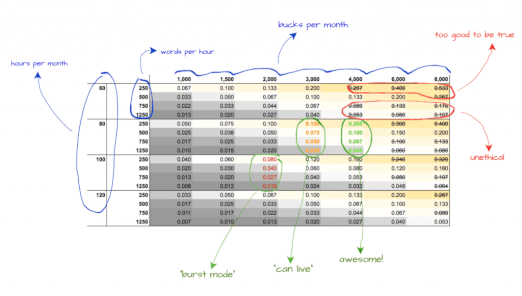Setting the translation rate can be tricky, especially for aspiring translators. On the one hand, you have to make sure your price is acceptable for the market. On the other hand, you want to secure a decent living and not undersell yourself.
The following cheatsheet will help you quickly map your capabilities and expectations to a rate you can agree on.
1 — Start with yourself
New Smartcat users — especially those who are just starting their career as translators — often ask us what rates they should set for their translation services. My advice is to forget about the market for a while, and start with themselves.
That's why I decided to share a simple spreadsheet that I created a while ago (feel free to copy it for adjustments). It will help you quickly determine what rate to set — or how good a given rate is — based on your needs and abilities.
Here's a screenshot:
So what do we have here?
2 — Understand how hard you can work
In the "big" rows, we have your anticipated effort in hours per month:
80 hours per month is a comfortable mean, corresponding to around 4 hours of pure work per day (restroom/smoking/having a lunch/procrastinating on Facebook excluded).
60 hours per month is easy and suitable for someone whose life-work balance tends to the former.
Above 100 hours per month, things start getting messy, as it's really hard to stay focused if you translate for more than 5 hours a day, every day (remember, we are talking about pure work).
120 hours per month is, at least for me, the absolute maximum I can bear. This means either working 6 hours a day every day, or "binge working" for even longer on individual days. Either makes you physically exhausted and morally depleted, and I strongly suggest to avoid such overtimes at all costs.
3 — Find out how fast you can translate
In the "small" rows (repeated for each "big" row), you have your translation speed in words per hour:
500 words per hour is the average speed for a standard translation, with moderately difficult terminology and grammar.
250 words per hour is applicable for complex technical translations, literary translation, and transcreation assignments.
750 words per hour can be achieved, if the customer doesn't have strict quality requirements (say, they want to understand what's written in an article).
1250 words per hour is the absolute maximum one can achieve if they post-edit a machine translation, and the customer doesn't look for stylistic/terminological consistency.
4 — Think of how much you want to earn
In columns, you have your desired income level per month. Of course, these values will vary greatly based on your location, social/marital/parental status and lifestyle. That's why they should be adjusted (as described below) in line with the following general levels:
Absolute minimum ($1000/month in this example): a level at which you actually lose money, but not so fast as to become bankrupt in a couple of months (you'll need this time to grow bigger).
Minimum sustainable level (here $2000/month): a level at which you can live for a while, covering just your basic living needs.
Normal level (here $4000/month): a level when you can live according to your reasonable expectations of what "good living" is.
Maximum happiness level (here $6000/month): a level that makes you praise yourself for having become a translator, while drinking piña colada somewhere in the Caribbean.
5 — Bring it all together
All the above data are editable in the Parameters tab of the spreadsheet:
Now, after we've defined our parameters, let's look at the cheatsheet once again:
Each cell represents the translation rate that you need to seek if you want to earn a given amount by translating for a given time at a given speed. Rates are color-coded from grey to white to yellow for a convenient visual representation of "where the gold mines are."
6 — Identify translation rate groups by awesomeness
Now, highlight — at your own discretion — three "blocks", or sets of parameters (as circled in the screenshot):
"Red" block: something you could bear for a short while to get into the market/win a customer/gain experience. (In my example, this means working 100 hours a month while earning $2000.)
"Orange" block: something that ensures your comfortable living (here, working 80 hours and earning $3000.)
"Green" block: something that makes you really satisfied with your work ($4000 for 80 hours in this case).
Now you can easily see (a) where you are with the current rates, and (b) where you should be heading to make your work more comfortable for you.
7 — Strike out what's irrelevant
The final thing to keep in mind is that not every rate you will get in the spreadsheet is relevant. For me, for instance:
Any rate above $0.20 per word is irrelevant. Okay, this could be different if I were translating poetry — but in such a case I would most likely charge per hour anyway*.
Rates above $0.08 per word is irrelevant for loose translations. I just don't have the gall to charge customers a translation rate of $0.08 if I know that I would be translating it in a "quick and dirty" fashion.
Anything above $0.05 is irrelevant for post-editing assignments. The same here: you just can't charge for post-editing something that high (and something that is an average rate for "normal" translation for many other translators).
* There definitely are translators who charge more, but I just don't consider myself in that league. Striking this out helps me understand the "zones" that I shouldn't even consider as a goal (say, earning $8000 by working 60 hours per months and translating at 250 words per hour).
Examples
Here are a couple of examples to illustrate how you can use the spreadsheet:
Defining you rate. A customer approaches you with a transcreation request. This is a very important customer, so you are willing to go into "burst mode" to get this job. You go to the "red" block of the cheatsheet and see that in this case you can offer them a translation rate of $0.08 per word. But you also tell them that if they like your work, further projects will come at a price of (consulting with the "orange" block) $0.15 per source word. The customer is happy because this is a very good price now, and you in turn know exactly what you are going for.
Finding out if a proposed rate is good enough. A customer has a post-editing assignment with no strict quality requirements that he has an approved translation rate of $0.03/word for. You find that it is exactly the value you have for such work in the "orange" block, meaning rather comfortable conditions for you. You agree, but keep in mind that in future you would probably ask them to increase the translation rate to $0.04 (the "green" block).
Finding out if work already made had a good rate. You have completed an assignment at $0.08/word, and your speed was 750 words per hour. You find that this value is even higher than that in the "green" block, meaning that it was a very good rate for that task.
Of course, this cheatsheet has nothing but very simple arithmetical calculations in it — but I found it very useful for quickly tackling the above tasks. It does not claim to be the one-size-fits-all solution for setting your translation rate (there is none!) — but I believe it's a good starting point for those who are only starting to get the hang of it. What about you? Do you have your own tips and tricks for choosing your translation rate? — If you liked this article, feel free to subscribe to our blog or follow us on LinkedIn and Facebook!
Subscribe to our newsletter


